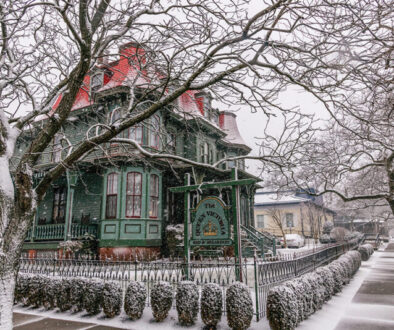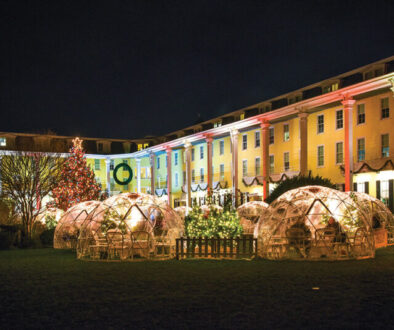Prime Selections
Crème de la Crème
What is your favorite dessert? I ask this question every time I have dinner guests. And, although I don’t really keep track of such things, crème brûlée is the answer more often than anything else. I am always delighted to indulge my friends because this impressive, somewhat decadent luxury is inexpensive, quick, and easy to make. It’s really just baked custard topped with burnt sugar. If you were to dip bread in it rather than bake it, you could have French toast. If you cooked it on the stove, you’d have pastry cream. And if you froze it, you would have ice cream!

Around the World
What I find extraordinary is its universal appeal. Why are people so crazy about it? Perhaps, like many great epicurean delights, it is the juxtaposition of textures and flavors that makes it so appealing. I think it just feels good in your mouth. It’s creamy and crunchy. It’s sweet, but not too sweet. And like Jell-O, you always seem to have room for it. It’s also at home with any cuisine. So, it’s the perfect ending to any meal no matter what came before it.
Some form of baked custard is found in almost every cuisine around the world. The Spanish call it flan or natillas, which is flavored with cinnamon. Flan is also a favorite in the Philippines and Mexico. In Brazil, they make it with coconut milk and call it baba-de-moça. The French make pots de crème, crème caramel and of course, crème brûlée. They also thin it down to make a sauce called crème anglaise. Bavarian cream is a variation native to Germany. In Portugal, it’s leite de crème. In Japan, purin. In Brazil, they put it on top of a macaroon crust and call it quindim. The Greeks add phyllo dough and call it galaktoboureko. In China and Hong Kong, the custard is served in tart shells. The Italians substitute Marsala wine for the cream and make zabaglione. (If you’ve never had it, ladle some over fresh berries next summer. It’s pure heaven.) I could go on and on…
History
Custard (or flan) can be traced all the way back to the Roman Empire. According to Cucina.com, the Romans were the first to domesticate chickens for the purpose of harvesting their eggs. With this newfound abundance of eggs, they began developing new recipes and inventive methods of cooking the eggs. In the beginning, flan—or flado as it was called—was made as a savory treat, usually flavored with fish or meat and sprinkled with pepper. But it wasn’t until a sweeter version (flavored with honey) was created that the centuries-old love affair with custard began. The Roman Empire fell in 476 A.D., but flan survived.
Some experts debate that the earliest versions of crème brûlée were English or French, but the Spanish were actually the first to top it with caramel sauce. They also developed Crema catalana, which has a burnt sugar topping that can be traced back to the 14th century, some three hundred years before the first records of French crème brûlée. Like the Romans before them, the Spanish took their recipes with them as they explored and conquered new lands. In 1518, it arrived on the Yucatan Peninsula, and the Mexicans began putting their own twist on it, adding coffee, chocolate, and coconut.
In the U.S., crème brûlée dates back to the days of Thomas Jefferson when he asked that it be served at the White House. It was all the rage in the 1950’s and 60s, appearing in restaurants, cookbooks and magazines. Then, for some unknown reason, it fell out of favor for at least a decade much to the dismay of James Beard, who lamented in a Los Angeles Times article that “in America we went through a great crème brûlée period a number of years ago and I wish we would again.” It only took about a decade for his dream to come true. As luck would have it, Sirio Maccioni, owner of the world famous Le Cirque restaurant in New York City, took a trip to Spain in the early 80’s and discovered Crema catalana. When he returned, he asked his pastry chef to create a version for the restaurant. The rest is history.
Crème Brûlée is so popular that a quick internet search revealed at least a dozen cookbooks on this singular treat. Now, not only is it a dessert, but the words crème brûlée are used to describe almost anything that is vanilla flavored – from ice cream and coffee to French toast and yogurt. Great chefs everywhere have put their own spin on it adding flavors like pumpkin and even fois gras. But being the purist that I am, I prefer to leave perfection unadulterated!
Recipe Dos and Don’ts
This exquisite dessert is sublimely simple to prepare. After all, it’s only eggs, cream, sugar, and vanilla. However, it does require a little finesse. Here are a few things you should know:
1. Don’t overbeat the yolks. It results in more work later. (See tip #3)
2. Temper the cream by whisking a little of it into the yolks and then add the yolks back to the cream. Skipping this step can result in scrambled eggs!
3. Skim off as many bubbles as possible before baking.
4. Don’t overbake it. It loses its silky texture. Test with a sharp knife. If it comes out almost clean, it’s done.
5. Cool it completely and refrigerate to prevent further cooking before brûléeing with a torch.
6. The custard can be made ahead and baked later. It can also be baked ahead and brûléed right before serving. Just don’t refrigerate it after you brûlée. The sugar loses its crunch and turns into a sweet watery topping.
I have been delighting my friends and family with crème brûlée for decades, but it wasn’t until I was completing my research for this article that I realized the recipe I have been using came from Le Cirque. It was given to me by a friend of a friend who had clipped out of The New York Times in the mid-80s. This version, in my opinion, is perfect. I have never been tempted to tinker with it except to use flatter crème brûlée dishes and reduce the cooking time to 40 to 45 minutes. I have also found that straining isn’t necessary.

Crème Brûlée (serves eight)
4 c. heavy cream
1 vanilla bean
¼ tsp. salt
8 egg yolks
¾ c. sugar + 2 Tbsp.
1 c. light brown sugar for topping
Preheat oven to 300 degrees. In a saucepan over low heat, combine cream, vanilla bean and salt and simmer for 5 minutes. Remove vanilla bean and scrape the seeds into the cream.
In a large bowl, combine egg yolks and granulated sugar. Pour in hot cream and stir mixture gently to combine. Strain custard into a pitcher and skim off any bubbles.
Place 8 three-quarter-cup ramekins or ceramic custard cups in a roasting pan. Pour custard into ramekins, filling to the rim. Place roasting pan in oven and carefully pour warm water into pan until it reaches halfway up sides of ramekins. Bake 1 hour and 15 minutes. Remove ramekins from water bath and cool. Cover and refrigerate for at least three hours, or as long as two days.
When ready to serve, preheat broiler. Uncover ramekins and place them on baking sheet. Top each with a thin layer of brown sugar. Use a knife to spread sugar evenly across the custards. Broil custards about 2 inches from flame for 30 seconds to 2 minutes until sugar is caramelized, watching constantly to make sure it does not burn. Or use a culinary torch to brûlée. Serve immediately.
Crème brûlée is an elegant ending for a holiday meal. But if you ask me, it’s perfect anytime, maybe even for breakfast!
Where in Cape May
You can enjoy crème brûlée right here in Cape May at the following fine dining establishments:
Hemingway’s, the Merion Inn, Peter Shields, Sapore Italiano, and Union Park.
More Tips
Crème brûlée is a perfect dessert to serve for a large party. Make mini brûlées using two-inch ramekins. Just make sure you reduce the cooking time and watch them carefully. Use a broiler to caramelize the sugar; torching takes forever!
Use the leftover egg whites for almond cake, omelets, royal icing, meringue, angel food cake, spiced nuts, Pavlova, or floating islands. You can also freeze them in an ice cube tray.
If you really love crème brûlée and plan to make it at least once a year, invest in a torch. It is well worth it.
White granulated sugar works just fine if you don’t happen to have light brown sugar on hand.
For something a little different, loosen the custards by running a sharp knife around the inside edge of each cup and unmold. Serve with praline sauce—c’est magnifique!



